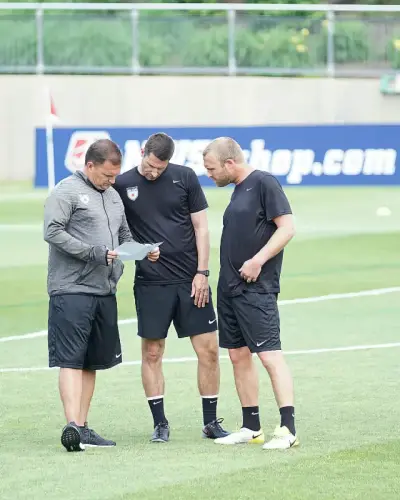Youth Development Club or Youth Joint Team: What's the Difference?
In youth football, it's becoming more common to see teams with the abbreviations JFV or JSG in their names. But what do these acronyms stand for? Let's break it down.
- JFV = Jugendförderverein (Youth Development Club)
- JSG = Jugendspielgemeinschaft (Youth Joint Team)
Both structures offer solutions for two key challenges in youth football: ensuring team viability and providing performance-oriented player development.
The Key Differences Between a Youth Development Club (JFV) and a Youth Joint Team (JSG)
Both JFVs and JSGs are formed with a common goal: to provide young players with a pathway for development and high-quality training conditions.
A Youth Joint Team (JSG) is typically created to maintain regional football opportunities.
Example:
In a rural area where three clubs exist within a 15km radius, each club may have enough players to field small-sided youth teams. However, from the C-Youth (U14-U15) level onwards, these clubs might struggle to form competitive full-sized teams due to a lack of players in specific age groups. The solution? A Youth Joint Team (JSG), where all three clubs pool their players together, ensuring that young footballers can continue playing locally without leaving their home clubs. This setup keeps children engaged in their sport, maintains their connection to their hometown teams, and prepares them to transition into the senior squads later on. A Youth Development Club (JFV), on the other hand, focuses primarily on high-performance training and development. The goal is to bring together the most talented young players in the region and give them the opportunity to train and compete at a higher level.
A JFV typically serves one of the following purposes:
- Preventing young talents from leaving the region for professional academy programs (NLZ - Nachwuchsleistungszentrum)
- Preparing players for an eventual move to an elite youth academy
- Developing highly skilled players who don’t necessarily aim for professional football but still want top-tier training and competition
Here too, multiple clubs collaborate by sending their most talented players to the Youth Development Club, allowing them to train in higher-quality environments and qualify for top youth leagues while still remaining connected to their home clubs.
Legal and Structural Differences
The legal distinction between a JFV and a JSG is significant.
A Youth Development Club (JFV) is an independent legal entity, officially recognized as a football club. It is formed by at least two clubs and often carries a regional name (e.g., JFV Lübeck or JFV Eichsfeld). This setup comes with all the responsibilities of a football club, including a board of directors, financial management, and legal obligations such as membership meetings and financial audits.
A Youth Joint Team (JSG) is not an independent club but rather a temporary collaboration between clubs. The regional or state football association must approve the formation of a JSG, which is typically renewed annually or every two years.
Advantages of a Youth Development Club (JFV)
As outlined above, the primary goal of a JFV is to provide young talents with the best possible football education. By gathering the most talented players from different clubs, JFVs create stronger training groups and competitive teams, often competing in higher-tier leagues such as state or regional leagues.
This structure enables young players to:
- Train at a high level with similarly skilled peers
- Compete against top regional clubs and professional youth academies
- Stay connected to their home club while benefiting from professional training structures
How to Establish a Youth Development Club (JFV) or a Youth Joint Team (JSG)
The formation of a Youth Joint Team (JSG) or a Youth Development Club (JFV) requires collaboration between multiple clubs. The first step is open discussions with neighboring clubs to assess the need for a joint program. If there is no agreement among clubs, the idea will not progress.
If discussions move forward and common goals are established, it is advisable to consult with regional or state football associations. They can provide guidance on legal, organizational, and sporting matters.
What Is Required for the Formation?
The most important requirement is a unified leadership team that shares the same vision.
In practice, many joint ventures fail due to minor disagreements such as:
- Which club's name should come first in the team’s official name?
- Who will be the head coach?
- Which club's colors will the team wear?
- Which club's facilities will be used more frequently?
However, if the primary focus remains on the benefits for young players and clubs, a common solution can always be found.
Pro Tip: Digital Management for JFV and JSG
To ensure efficient organization, it is highly recommended to use modern digital club management tools instead of outdated paper-based systems or Excel spreadsheets. This simplifies administration for club officials and coaches, covering areas such as:
- Training scheduling
- Field and facility management
- Travel logistics (team buses, shared transportation)
- Player registration and performance tracking
By embracing digital solutions, JFVs and JSGs can enhance their effectiveness and maximize the development of young footballers while reducing administrative burdens.
Conclusion
Both JFVs (Youth Development Clubs) and JSGs (Youth Joint Teams) provide structured pathways for young footballers but serve different purposes.
- JSGs allow small clubs to combine resources and retain local players, ensuring that youth teams remain viable at the regional level.
- JFVs focus on elite player development, helping talented young athletes compete at higher levels without losing ties to their home clubs.
Each model offers unique benefits, and the right choice depends on the specific goals and structure of the clubs involved.






